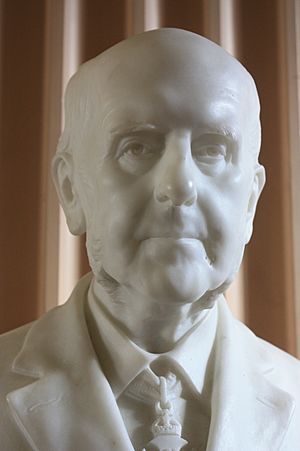Édouard Lantéri facts for kids
Quick facts for kids
Édouard Lantéri
|
|
|---|---|

Édouard Lantéri by Alphonse Legros
|
|
| Born | 31 October 1848 Auxerre, France
|
| Died | 22 December 1917 (aged 69) London, England
|
| Education | François-Joseph Duret, Aimé Millet, École des Beaux-Arts (Jean-Baptiste Claude Eugène Guillaume, Pierre-Jules Cavelier) |
| Known for | Sculpture |
| Movement | New Sculpture |
Édouard Lantéri (born October 31, 1848 – died December 22, 1917) was a talented sculptor and medallist. He was born in France but later became a British citizen. His romantic French style of sculpting was very important. It influenced many artists in a movement called New Sculpture. Sometimes, his name is spelled without the special French marks, like Edouard Lanteri. His first name is also sometimes given as Edward.
Contents
About Édouard Lantéri
Lantéri was born in Auxerre, France. He later decided to become a British citizen. He studied art at famous schools like the École des Beaux-Arts. His teachers included well-known artists such as François-Joseph Duret and Aimé Millet.
For a while, Lantéri faced tough times and worked as a cabinetmaker. But in 1872, when he was 24, he moved to London. He became an assistant to another sculptor, Joseph Edgar Boehm. Lantéri worked in Boehm's studio until 1890. He also influenced Boehm's student, Alfred Gilbert.
His Sculptures and Teaching
Lantéri mostly created his sculptures using clay first. These clay models were then used to make bronze statues. He also worked with stone. He made many different types of art. These included detailed busts (sculptures of heads and shoulders), small statuettes, and even life-size statues.
In 1880, Lantéri started teaching at the National Art Training School. This school later became the Royal College of Art in 1896. In 1900, he became the first Professor of Modelling there. He helped with the design of the Victoria and Albert Museum in London.
Books by Lantéri
Later in his life, Lantéri wrote a series of three important books. These books explained how to sculpt human and animal figures. They were first released as three separate books. Now, they are often found as two books, with animal sculpting separate from human form. These books are still used today. Many sculpture courses require students to read them. The famous sculptor Auguste Rodin wrote the introduction for the original book. Rodin called Lantéri his "Dear Master."
- Modelling; A Guide for Teachers and Students (three volumes), London, Chapman and Hall (1911)
- Modelling and Sculpting the Human Figure, Dover Publications Inc., new edition (1986)
- Modelling and Sculpting Animals, Dover Publications Inc., new edition (1986)
Students of Édouard Lantéri
Many artists learned from Lantéri. Some of his notable students include:
- William Kellock Brown
- Benjamin Clemens
- Alexander Carrick
- Margaret Giles
- Allen Hutchinson
- Charles Sargeant Jagger
- Gilbert Ledward
- Ruby Levick
- Walter Marsden
- Esther Moore
- Oliver Sheppard
- Clare Sheridan
- Francis Shurrock
- Lilian Simpson
- Florence Steele
- Albert Toft
- Reginald Fairfax Wells
- Charles Wheeler
- Lucy Gwendolen Williams
- Dorothy Stanton Wise
- Francis Derwent Wood
See also
 In Spanish: Edouard Lanteri para niños
In Spanish: Edouard Lanteri para niños


